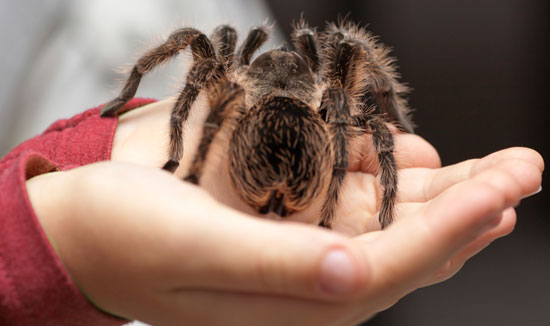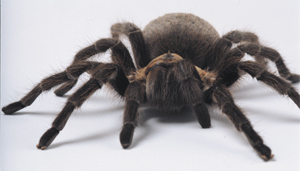How to Keep Spiders as Pets
Spiders can make fascinating pets. Here are a few steps to get you started keeping spiders.

Step 1: Catch a spider
Spiders are all around us, indoors and out, so they’re not hard to find. Some species can bite and a few are venomous. Learn about dangerous spiders in your area before heading out. It’s easy to safely catch a spider by using a small jar. Gently coax it into the jar using the lid. Spiders will eat each other, so keep only one per jar.
Step 2: Prepare a cage
Large spiders do well in the inexpensive plastic terrariums available from pet stores. Smaller ones can be kept in jars or plastic containers if air holes are drilled into the lid or sides. Be sure the holes are small enough to prevent escape.
Potting soil makes good cover for the cage bottom. Sticks, dead leaves or artificial plants provide structure for hiding, climbing and webbing.
Step 3: Water
Depending on the size of the spider, anything from a plastic bottle cap to a small bowl can serve as a water dish. Spiders also drink water sprayed on webbing, but you should never allow the cage to become damp.
Step 4: Feeding
Offer insect prey once or twice a week. Crickets are available from pet shops, or you can collect insects outdoors if no insecticides have been sprayed in the area.
Step 5: Observing
Watch your spider and take notes on its behavior. You won’t believe what happens in the spider’s web until you’ve visited it yourself!
PREFERRED PETS
 Not all spiders do well in captivity. Active hunters are usually easier to keep than web builders. Here are a few that make good pets.
Not all spiders do well in captivity. Active hunters are usually easier to keep than web builders. Here are a few that make good pets.
Tarantulas: Some species exceed 10 inches in legspan. They’re by far the most popular pet spiders and can be bought in pet stores.
Wolf Spiders: Some can be more than three inches in legspan. Large specimens do best in terrariums with lots of floor space.
Jumping Spiders: Although small and rarely exceeding half an inch, their jumping ability is amazing. Many species are brightly colored and can easily be kept in jars.
Fishing Spiders: In captivity, these large spiders appreciate vertically arranged pieces of bark for climbing. They’re very fast, so use caution when capturing them.
Grass Spiders: These spiders build funnel-shaped webs in grass, bushes and on buildings. In captivity, they will build extensive webs inside their cage.
LEARN MORE: Click here to see photos of a spider expert’s seven favorite spiders
Will they live 2x longer in captivity? because I want to catch a giant wolf spider, but I’m afraid when i catch it it will die within a few days because of its age… 🙁
i found 2 black spiders 4 daddy long legs and a brown one and keeping them all
i just found a spider that is about a half of a inch long and it has light brown legs and a dark brown body i found it in the grass what is it?
Sounds to me like a jumping spider if its web is wide probably an orb weaver if funnel more like probably jumping spider.
I would get nonvenomes spiders.
I have tranchalas,blackwidow,brownwidow,wolfspider,brownrecluse and hundred of spiders each feamale and male
the black widow is deadly brown recluse rots your skin
how do i care for my spider
I wish I would of read this information allot earlier, than may be my spider would still be alive today.
Bought Red Rose Hair tarantula like 2 or 3 years ago, awesome pet!
That’ so cool!
by the way i found a spider at the back of my old bag it has only 4 eyes and has red color on legs and brown body what is that??
Hey zeebedee I just Binged your description and found some pics and they matched your not-so-nameless-spider! It is called a Woodlouse spider.
prodly a grass or a wolf spiter
hey dude! i dont think its a spider. Spiders have 8 eyes
A woodlouse spider.
how do you tell if it`s a boy or a girl
i have no clue
i have a phidippus audax, a jumping spider, and all i did was simply go to google, and found out it was a male